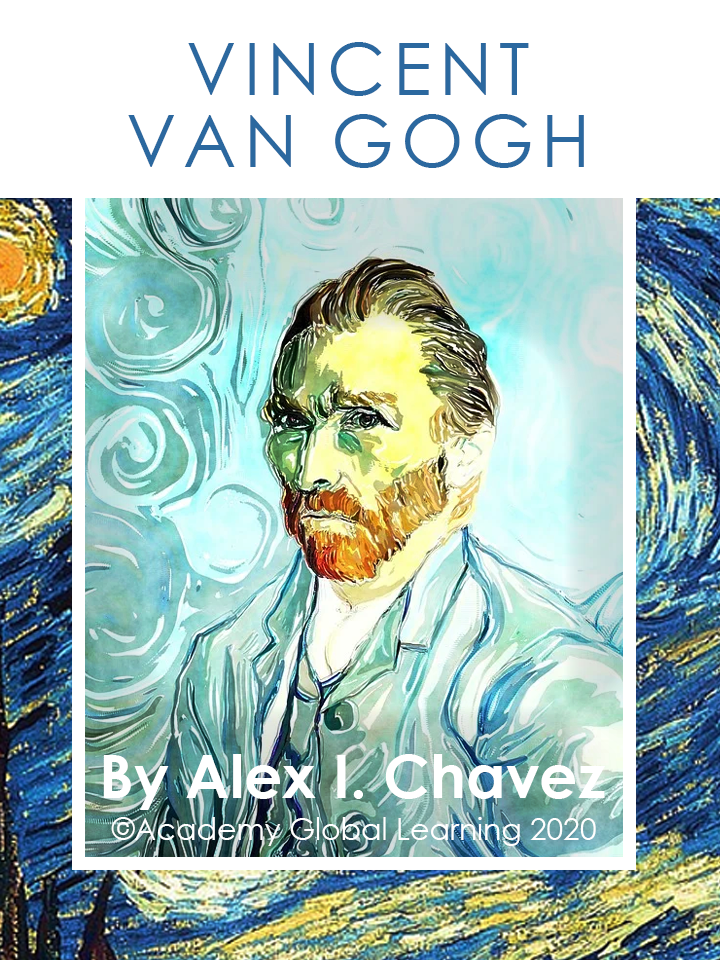

This book developed by ©Academy Global Learning 2020
All rights reserved under ©Academy Global Learning 2020. No part of this publication may be reproduced, stored in a retrieval system, or transmitted in any form or by any means, electronic, mechanical, photocopying, recording, or otherwise, without the prior written permission of the copyright owner.
Designed By:
Christian Alas
Created and illustrated By:
Angelo Romero and Camilo Sanabria
Vincent Van Gogh
Vincent Van Gogh was a very famous artist born in 1853 in the Netherlands. Van Gogh’s drawings and paintings are some of the world’s most renowned, most respected, and most expensive pieces.
During his early years he worked for a company of art dealers, then became a missionary worker in a very poor mining area. Not until he was 27 did he begin his career as an artist.

Historians are dubious about the reasons why he did not stick with these occupations. We are lucky today, though, that his initial life plans were foiled for whatever reason, because he became a remarkable artist. As a painter he initially only used darker colors and abstained from brighter ones.
But after he discovered Impressionism and Neo-Impressionism while in Paris, he became attached to the brighter colors and painting style. He would later develop this into his own unique style, which he fully developed while living in Arles, France.
Van Gogh grew up with his father, who was a minister of a church, his mom, two brothers, and three sisters. Unlike many children who might act in a despicable or subversive way, he was very quiet and contemplative as a child. This was mistaken as him being indifferent. This label, however, did not agitate or end up corrupting Van Gogh.
As a child he attended several schools throughout his youth and was often unhappy. This would foreshadow his later depression that oppressed him throughout life, resulting in his unfortunate mental state. In a way it empowered him to create his famous pieces instead of hampering his ability.

Some of Van Gogh’s most famous paintings include Portrait of Dr. Gachet, Still Life: Vase with Twelve Sunflowers, and The Starry Night. Although you may not recognize the names, you probably would recognize the paintings if they were shown to you. It would be surprising if you did not recognize at least some of them.
Perhaps the most important person in Van Gogh’s life was his brother, Theodorus, who constantly and unselfishly provided Vincent with financial support, keeping Van Gogh from spiraling down into a state of complete destruction. Although this indirect intervening did not completely eradicate Van Gogh’s suffering, it quelled it significantly.
Their lifelong friendship is evidenced through an abundance of letters they exchanged with each other. Their relationship provided Van Gogh with at least something of an escape from his mind, which was his nemesis.
His brother’s support was not enough, however, to avert Van Gogh from finally giving in to his depression.

Van Gogh produced more than 2,000 pieces of art during the last ten years of his life. He was a pioneer of what came to be known as Expressionism and had a tremendous influence on 20th century art. Most of his best-known works were created in the last two years of his life, during which time he was so distraught over the failure of his friendship with fellow artist Paul Gauguin that he sliced off part of his own left ear.
Gauguin was more of a friend than a sinister adversary, but his decision to repel Van Gogh’s friendship proved treacherous and turned Van Gogh’s depression into a predator of his mind.
Unfortunately, Van Gogh had endured too much and was never able to successfully confront the depression that besieged him. He was unable to vanquish the demons inside him that eventually subdued him. In 1890 acting as his own assailant, he did an abominable thing and took his own life.
Although his life ended prematurely due to the menacing depression, Van Gogh had already produced enough art pieces to continue his legacy and show the world his brilliance. Parts of his life may have gotten him labeled as a fanatic, but no one can deny he was also an artistic genius. We are lucky that Van Gogh’s works are on display today and were never annihilated.




 Early Civilizations in the Mesopotamian Valley and Nile Valley
Early Civilizations in the Mesopotamian Valley and Nile Valley  Introduction to World History
Introduction to World History  Zebras | Tagalog | 2022
Zebras | Tagalog | 2022  Penguins | Tagalog | 2022
Penguins | Tagalog | 2022  Penguins
Penguins  Stars
Stars  Vietnam
Vietnam  Galaxy
Galaxy  University
University  Zebras
Zebras  Penguins | Ukrainian
Penguins | Ukrainian  Penguins | Estonian
Penguins | Estonian  Penguins | Turkmen
Penguins | Turkmen  Robots | Ukrainian
Robots | Ukrainian  Robotid | Estonian
Robotid | Estonian  Robots | Turkmen | 2025
Robots | Turkmen | 2025  Unit 1 – Maïs – French – Beginning
Unit 1 – Maïs – French – Beginning  Planeta – Unidad 1 – Español – Advanced
Planeta – Unidad 1 – Español – Advanced  HS – ESL3 – Unit 17 – Mustang– Moodle
HS – ESL3 – Unit 17 – Mustang– Moodle  HS – ESL3 – Unit 16 – Reading – Moodle
HS – ESL3 – Unit 16 – Reading – Moodle